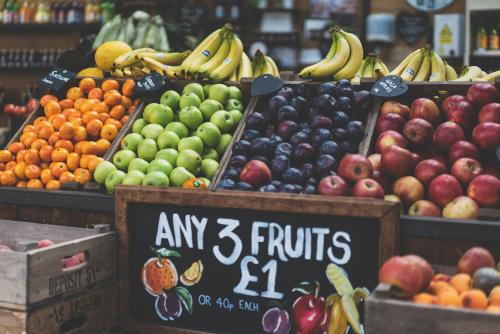Over the years successive UK governments have implemented various policies to encourage fruit and vegetable consumption. Some of these policies include The Healthy Start Scheme, School Fruit and Vegetable Scheme, Eat Them to Defeat Them Campaign, Government Food Strategy, and the Blueprint for Growing the UK Fruit and Vegetable Sector as well as the popular Five-a-day campaign. The latter was launched in March 2003 to encourage people to increase their intake of fruits and vegetables to at least 400 grams/person/day (i.e., 5 daily portions of 80 grams). However, existing evidence indicates that despite the implementation of these policies, fruit and vegetable consumption in Scotland still remains below the recommended level.
.png)
Figure 1. Trends in daily home fruit and vegetable intake in Scotland (Source: Own elaboration based on Kantar Worldpanel data)
Figure 1 shows the trends in daily consumption of fruits and vegetables (estimated per statistical month, i.e., every four weeks) compared to the recommended intake of 400 grams/person/day, from 2006 until 2023. These data exclude any fruit and vegetables consumed out of the household, which according to the latest Defra’s Family Food Statistics represent about 2% of the total consumption of fruit and vegetables (excluding potatoes). However, the data include both fresh and processed (canned and frozen) fruits and vegetables.
Three main observations can be made from the graph:
First, it shows that the consumption of fruits and vegetables has been consistently below the recommended intake for the entire period. The gap (i.e., the distance from the daily purchases to the 400 grams/capita/day) has been as large as -238 grams/person/day (point A) and as low as -157 grams/person/day (point B).
Second, the quality of diet is not stable during the year as the consumption of fruits and vegetables is influenced significantly by seasonal factors – i.e., the demand is higher and lower in certain months of the year, evident from the peaks and troughs in the fruit and vegetables consumption. This coincides with the evidence presented by SEFARI colleagues (in de Roos et al., 2016) which found slightly higher expenditure on all fresh foods and fruit and vegetables in summer across urban and rural areas.
Third, consumption or demand for fruits and vegetables shows a decreasing trend from 2006 until the beginning of 2014 when it changes direction and started to increase. The peak in July 2020 is likely driven by pandemic-related lifestyle changes. Since then, the consumption of fruits and vegetables has started to decline. The latest figures indicate levels similar to those observed in 2013.
Drawing implications from the data in Figure 1, it seems clear that policies devised to date have been unsuccessful in increasing daily fruit and vegetable consumption towards the recommended intake of 400 g/person/day. Although it is difficult to estimate the contributions of these policies alone on the consumption of fruits and vegetables. We can, however, be certain more needs to be done in order to achieve the targeted intake.
Furthermore, analysis of the origin of the fruit and vegetables purchased in Scotland for household consumption, offers another insight into these issues. Figure 2 below presents the composition of the purchases of fresh fruit and vegetable by origin (from the UK, the EU and the rest of the world). Processed fruit and vegetables are not considered in the graph because it is not possible to determine their origin.
.png)
Figure 2. Contribution of the origin of fresh fruit and vegetables to national target (Source: Own elaboration based on Kantar Worldpanel data)
Figure 2 highlights the significant role of imported (EU and rest of the world) fruits and vegetables in Scotland’s purchases.
Firstly, fruits and vegetables from outside the UK contribute significantly to the retail supply of fruits and vegetables. Those coming from the rest of the world contribute between 87 – 127 grams/person/day of the intake, the EU contributes between 30 - 52 grams/person/day of the intake. The UK grown fruit and vegetables have become somewhat more prominent after 2020 slightly surpassing EU contributions.
Secondly, the UK (including Scotland) relies heavily on external suppliers to meet its domestic fruit and vegetable consumption. Moreover, the fact that imports play a significant role indicates that favourable trade policies are an important requirement for us to achieve the recommended levels of fruits and vegetables intake,
Finally, Figure 2 also indicates that despite the possibility to increase the domestic availability via trade, Scotland still is not able to meet the recommended intake. This indicates a demand and not a supply problem. In other words, the expansion of the consumption is not something that could be achieved by increasing the domestic production of fruit and vegetables in Scotland and/or the UK, because that could only be achieved by either massively reducing their cost of production or increasing the price paid to domestic producers.
Together Figures 1 and 2 show the consumption of fruits and vegetables is not stable over the year. Therefore, the compliance of the five a day also varies with seasonality and whether this is due to supply (from domestic production or trade) or demand factors (habits) is something that requires further investigation.
In conclusion, despite various policies and campaigns aimed at increasing fruit and vegetable consumption in Scotland, the intake remains below the recommended 400 grams per person per day. The data indicates that consumption is influenced by seasonal factors and has shown fluctuations over the years, with a notable decline after a peak in 2020 (during the COVID-19 lockdown). Additionally, Scotland relies heavily on imported fruits and vegetables, highlighting the importance of favourable trade policies. To achieve the five-a-day target, existing policies should be strengthened. Also, more effective strategies are needed to address both supply and demand issues, ensuring consistent and increased consumption of fruits and vegetables throughout the year. Further investigation into the factors affecting these trends is essential for developing successful interventions.
Written by Wisdom Dogbe (The Rowett Institute, University of Aberdeen), Cesar Revoredo-Giha (Scotland’s Rural College, Edinburgh) and Shashika Rathnayaka (The Rowett Institute, University of Aberdeen).
